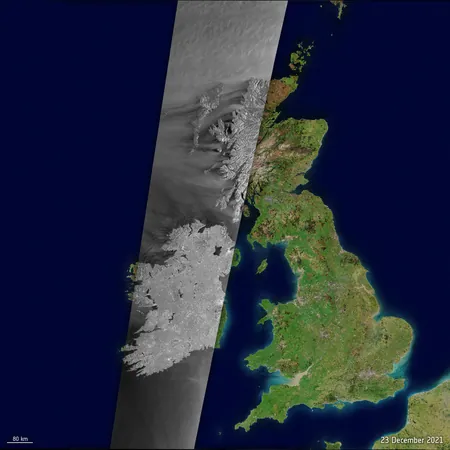
The Final Farewell: Sentinel-1B Completes Its Journey Back to Earth
2024-09-23
Author: Sarah
The Final Farewell: Sentinel-1B Completes Its Journey Back to Earth
On September 12, 2024, the Sentinel-1B satellite, a key asset of the Copernicus program, has officially completed its disposal process, marking the end of its operational life. This sophisticated satellite was instrumental in providing a wealth of radar data for over five years, making immeasurable contributions to various global initiatives, and its final transition underscores the European Space Agency’s (ESA) unwavering dedication to space safety and sustainability.
Tracing the Journey of Sentinel-1B
Launched on April 25, 2016, Sentinel-1B joined forces with its twin, Sentinel-1A, to create one of the most powerful radar imaging constellations in space. Their collaborative efforts generated the largest open global dataset of radar imaging, proving essential for a multitude of applications, from monitoring ice movements and glacier velocities to providing support in disaster response scenarios.
However, disaster struck on December 23, 2021, when a failure occurred in the satellite's power unit, causing the Synthetic Aperture Radar to become inactive, prompting a series of unsuccessful recovery attempts. The mission was officially declared over on August 3, 2022, leaving only Sentinel-1A to carry on.
Meticulous Disposal Strategy
Following the cessation of operation, the ESA team set to work on a meticulously crafted disposal plan designed to minimize the risk of space debris. This process emphasized collaboration with the European Commission and various industrial partners, ensuring Sentinel-1B's transition was methodical and well-structured:
1. **Orbit Lowering**: The spacecraft’s orbit was strategically reduced to accommodate upcoming satellites, including Sentinel-1C and Sentinel-1D.
2. **Testing Maneuvers**: New methods for further orbit lowering were validated to ensure controlled descent.
3. **Final Orbit Adjustment**: Ultimately, the satellite was maneuvered into a final orbit from which it would decay naturally and re-enter Earth’s atmosphere.
4. **Passivation**: Reservoir energy was minimized by discharging the onboard battery and shutting down all systems to prevent unintentional breakups.
The disposal operations commenced in February 2023. While the initial phase proceeded as planned, challenges arose as the orbit adjustments progressed. By April 2024, the team achieved the target altitude for re-entry within 25 years, and on September 12, 2024, the electrical systems were fully disabled, marking the official closure of Sentinel-1B's operational timeline.
Monitoring the Final Journey
The last message from Sentinel-1B reached command centers on September 12, as the satellite transitioned into a 'ballistic' state, no longer under operational control. Notably, this allows for accurate tracking by international space tracking networks, which will monitor its eventual re-entry into the atmosphere—projected for 24 years from now but subject to fluctuations driven by solar activity and atmospheric changes.
Legacy Live On
While Sentinel-1B may have concluded its mission, the impact of its data continues to resonate. Daily, thousands worldwide utilize the unprecedented data it amassed, now stored in the Copernicus Data Space Ecosystem, fostering a deeper understanding of our planet.
Anticipation builds for the arrival of its successor, Sentinel-1C, expected to launch on a Vega-C rocket at the close of 2024, ensuring that the vital services originally offered by Sentinel-1B remain uninterrupted. Together with Sentinel-1D, this new phase of satellites will set a course for the future, further enhancing our capability to monitor Earth for the next decade.
Stay Tuned!
As we bid farewell to Sentinel-1B, keep an eye on our coverage for the upcoming launch of Sentinel-1C! Could this new satellite push the boundaries of Earth observation even further? Don’t miss any updates on its groundbreaking mission!


 Brasil (PT)
Brasil (PT)
 Canada (EN)
Canada (EN)
 Chile (ES)
Chile (ES)
 Česko (CS)
Česko (CS)
 대한민국 (KO)
대한민국 (KO)
 España (ES)
España (ES)
 France (FR)
France (FR)
 Hong Kong (EN)
Hong Kong (EN)
 Italia (IT)
Italia (IT)
 日本 (JA)
日本 (JA)
 Magyarország (HU)
Magyarország (HU)
 Norge (NO)
Norge (NO)
 Polska (PL)
Polska (PL)
 Schweiz (DE)
Schweiz (DE)
 Singapore (EN)
Singapore (EN)
 Sverige (SV)
Sverige (SV)
 Suomi (FI)
Suomi (FI)
 Türkiye (TR)
Türkiye (TR)
 الإمارات العربية المتحدة (AR)
الإمارات العربية المتحدة (AR)